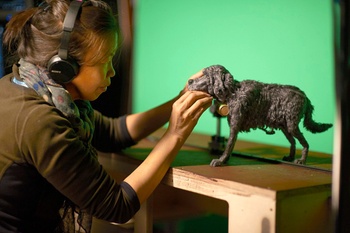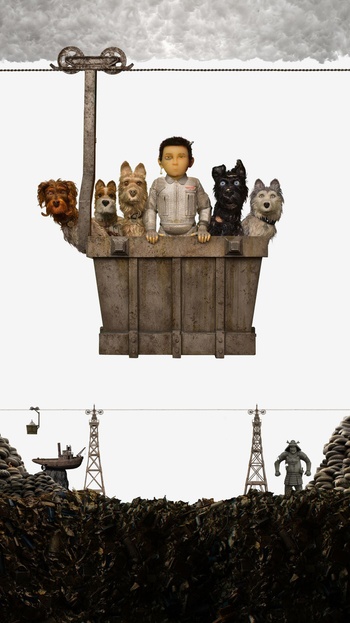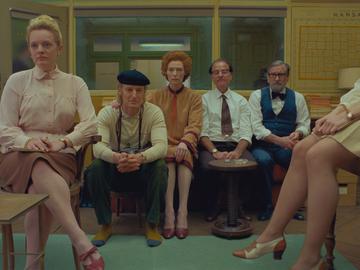Who could possibly animate the dogs in my new stop-motion gem Isle of Dogs? Wes Anderson did not have to wrestle with that question. It was a bone Kim Keukeleire, the Brussels-based talent who had previously worked on Fantastic Mr. Fox, could really sink her teeth into. “We weren’t trying to hide that they are puppets.”
Isle of Dogs
Is Wes Anderson’s Isle of Dogs a dog film to which even inveterate cat lovers will meekly have to bow their heads? It certainly looks that way. The refined director of Moonrise Kingdom and The Grand Budapest Hotel unleashed his imagination on a dystopian story about dogs that are exiled to a Japanese island/garbage dump. Just like Fantastic Mr. Fox, Isle of Dogs is a stop-motion film. The dogs are furry puppets. The illusion of movement is created by showing more than 130,000 stills in quick succession. Stop-motion is an exceptionally time-consuming, labour-intensive technique that few creative artists have mastered. The Brussels-based Kim Keukeleire is part of the select group who have. She is an alumna of the Brussels École nationale supérieure des arts visuels, also known as La Cambre, and has worked for big names like Tim Burton and Nick Park (Aardman), and her name appears in the credits of the superlative animated films Chicken Run, Frankenweenie, and Ma vie de Courgette.

Kim Keukeleire at work
You are the lead animator of Isle of Dogs. Forgive the question, but what exactly does that mean?
Kim Keukeleire: Don’t apologize, it is a completely normal question. Few people actually know what a lead animator does. He or she animates key scenes in the film. Wes Anderson reserved a few important sequences just for me and involved me in the project in its early stages. A month and a half before we started shooting, we tested all the puppets. Were they all appropriate for the animation? We coordinated with the puppet makers to make a few changes to each puppet before we started filming.
Based on Anderson’s guidelines, I came up with the movements and body language that would express the character’s personalities. I developed how the characters move and how that makes each one of them different. Using this information, I developed examples for the animators who joined the crew later on. For this film, I worked mostly on [the dogs] Spots and Jupiter, and [the 12-year-old hero] Atari.
Wes Anderson leaves nothing to chance or coincidence. A five-millimetre detail on a fork has to look exactly like he imagined it.
This was your second collaboration with Wes Anderson, but apparently he asked you to leave all your experience at the door and start from scratch.
Keukeleire: That wasn’t really how I experienced it. Isle of Dogs is so different from Fantastic Mr. Fox that it simply made no sense to recycle anything. The characters are incomparable and the physiognomy of the puppets is completely different. In Fantastic Mr. Fox, the animals were anthropomorphized: they wore clothes and had arms, hands, and fingers. Isle of Dogs has dogs that walk on four paws. Sporadically, there are human gestures, but they usually just behave like dogs. Although, of course, they do speak English.
There is a lot of character in the animation itself. The movements are not all perfectly streamlined. Are viewers supposed to see that the film is hand-crafted?
Keukeleire: In broad strokes, yes, that is Wes Anderson’s basic principle. His aesthetic rules deviate from the norm. He doesn’t want hyper-technical, flowing animation the way Tim Burton would, for example. It doesn’t necessarily have to be realistic. He prefers lively, spontaneous animation. He is incredibly meticulous about certain details, but will completely ignore certain imperfections or mistakes in the animation. It is OK if the viewer can tell that this is hand-crafted. It is not a problem if you can tell that they are really puppets and that their hair sometimes trembles because we can’t control the fur completely. There is something charming about that and it doesn’t stop the viewer from becoming engrossed in the film.

King, Boss, Rex, the twelve-year-old boy Atari, Chief, and Duke hovering over the Isle of Dogs.
Do you agree with that philosophy?
Keukeleire: Some of the animators did occasionally find it difficult that Wes Anderson doesn’t strive for classical, flowing animation, but I have no problem with it whatsoever. Every director has their own style. As far as I am concerned, my animation is successful if I have managed to translate the director’s vision onto the screen. I have to transform their ideas into movement. That determines the success of each take, not whether the animation is perfectly realistic or not.
What is it like to work with a control freak like Wes Anderson?
Keukeleire: Wes Anderson is a lovely man and he has profound respect for the work of the crew. But I actually didn’t spend very much time with him. Almost all of our communication was over e-mail. There is nothing unusual about that. I saw Tim Burton even less when we worked together. But don’t imagine this means that they don’t work on their films. Wes Anderson was hyper involved and spent two years working on Isle of Dogs, almost 24 hours a day. He leaves nothing to chance or coincidence. A five-millimetre detail on a fork has to look exactly like he imagined it.
When do you decide to take on a project? I see that you also animated the funny adverts for De Lijn and Tirlemont Sugar.
Keukeleire: Wes Anderson can call anytime. I admire his style, creativity, and the worlds that he evokes. But otherwise I like variety. Advertising is fun because they are always short, fast projects. I enjoyed Ma vie de Courgette because it was very different: I was the animation director. The budget was quite tight – even miniscule compared to a Wes Anderson film – but we nevertheless made something fun, coherent, and moving.
Sometimes I like responsibility, but sometimes I prefer to take a backseat and do ordinary animation. Modest animated series can also be fun. The location also plays a role. Animators live nomadic lives. I will only go to awful places in the world for very exciting projects. Living in an earthly paradise, it doesn’t matter so much if the projects are less exciting or ambitious.
The trailer of Isle of Dogs
Were you allowed to take any of the puppets from Isle of Dogs home with you?
Keukeleire: That wasn’t really an option. A model like that costs 40,000 pounds. I would have loved to keep one because you do really get attached to them. Maybe you could suggest the idea to Wes Anderson?
Isle of Dogs
US, dir.: Wes Anderson
Screening + introduction by Kim Keukeleire: 12/4, 19.10, Cinema Palace
Read more about: Film , Kim Keukeleire , Wes Anderson , Isle of Dogs




Fijn dat je wil reageren. Wie reageert, gaat akkoord met onze huisregels. Hoe reageren via Disqus? Een woordje uitleg.